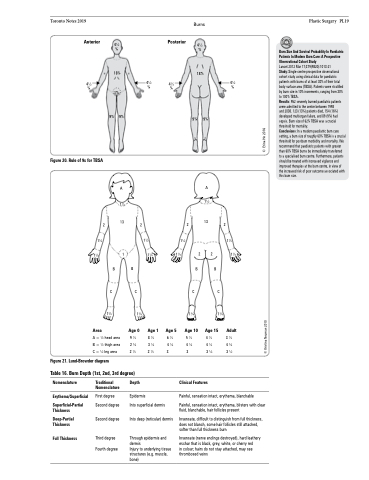Page 1141 - TNFlipTest
P. 1141
Toronto Notes 2019 Burns
Plastic Surgery PL19
Anterior
41⁄2 Posterior 41⁄2 %%
18%
18%
Burn Size And Survival Probability In Paediatric Patients In Modern Burn Care: A Prospective Observational Cohort Study
Lancet 2012 Mar 17;379(9820):1013-21
Study: Single-centre prospective observational cohort study using clinical data for paediatric patients with burns of at least 30% of their total
41⁄2 41⁄2 41⁄2 %%%% body surface area (TBSA). Patients were stratified
41⁄2
Figure 20. Rule of 9s for TBSA
1%
9% 9%
A 11⁄2
9% 9%
A 11⁄2
2 13 2
by burn size in 10% increments, ranging from 30% to 100% TBSA.
Results: 952 severely burned paediatric patients were admitted to the centre between 1998
and 2008. 123 (13%) patients died, 154 (16%) developed multiorgan failure, and 89 (9%) had sepsis. Burn size of 62% TBSA was a crucial threshold for mortality.
Conclusions: In a modern paediatric burn care setting, a burn size of roughly 60% TBSA is a crucial threshold for postburn morbidity and mortality. We recommend that paediatric patients with greater than 60% TBSA burns be immediately transferred to a specialised burn centre. Furthermore, patients should be treated with increased vigilance and improved therapies at the burn centre, in view of the increased risk of poor outcome associated with this burn size.
2 13 2
11⁄2 11⁄2 11⁄2 11⁄2
11⁄4
1 11⁄4 11⁄4 2 2 11⁄4 BB BB
CC CC
13⁄4 13⁄4 13⁄4 13⁄4
Figure 21. Lund-Browder diagram
Table 16. Burn Depth (1st, 2nd, 3rd degree)
Area
A = 1⁄2 head area B = 1⁄2 thigh area C = 1⁄2 leg area
Age 0
9 1⁄2 2 3⁄4 2 1⁄2
Age 1
8 1⁄2 3 1⁄4 2 1⁄2
Epidermis
Into superficial dermis
Age 5
6 1⁄2 4 1⁄4 3
Age 10 Age 15 Adult
51⁄2 41⁄2 31⁄2 41⁄4 41⁄2 43⁄4 3 31⁄4 31⁄2
Clinical Features
Painful, sensation intact, erythema, blanchable
Painful, sensation intact, erythema, blisters with clear fluid, blanchable, hair follicles present
Insensate, difficult to distinguish from full thickness, does not blanch, some hair follicles still attached, softer than full thickness burn
Insensate (nerve endings destroyed), hard leathery eschar that is black, grey, white, or cherry red
in colour; hairs do not stay attached, may see thrombosed veins
Nomenclature
Erythema/Superficial
Superficial-Partial Thickness
Deep-Partial Thickness
Full Thickness
Traditional Nomenclature
First degree Second degree
Second degree
Third degree Fourth degree
Depth
Into deep (reticular) dermis
Through epidermis and dermis
Injury to underlying tissue structures (e.g. muscle, bone)
© Kristina Neuman 2010
© Erina He 2016


